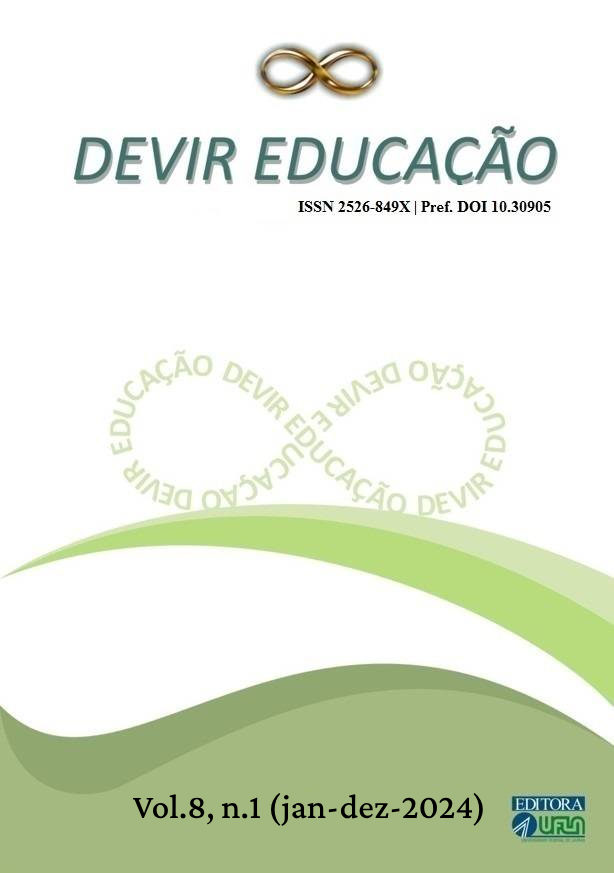An analysis of the aggressor in the bullying phenomenon
DOI:
https://doi.org/10.30905/rde.v8i1.826Keywords:
Bullying, Aggressor, School.Abstract
The theme of violence at school is identified by the phenomenon of bullying, which involves children and adolescents. This article aimed to identify, based on scientific literature, who is the perpetrator of bullying, who assumes the role of aggressor in this process. A bibliographical search was carried out in the Scielo database. Initially, thirty articles were found. After applying the inclusion and exclusion criteria, 10 studies were selected to compose the analysis corpus. The results revealed that bullying is understood as a way of designating aggressive behaviors practiced by the aggressor, in which there are suffering and anguish among the victims. Those involved are the victim, the aggressor and the witness. The aggressor is involved in fights, dissatisfied with life, has difficulties in relationships with parents. In addition to being aggressive, angry, has low self-control and low pleasantness. The impacts on the lives of those involved are countless, and much of the violence experienced in childhood or adolescence can be perpetuated, with cases of bullying at work. It is essential to identify bullying practices early, to avoid creating a hostile environment at school and even prevent the practice of crimes and use of drug. Furthermore, it is understood that it is essential that new research and studies be carried out to expand knowledge on this topic.
Downloads
References
ALCANTARA, Stefania Carneiro de et al. Violência entre pares, clima escolar e contextos de desenvolvimento: suas implicações no bem-estar. Ciência & Saúde Coletiva, v. 24, p. 509-522, 2019. Disponível em: https://www.scielosp.org/pdf/csc/2019.v24n2/509-522/pt. Acesso em: 15 jul. 2023.
ALCKMIN-CARVALHO, Felipe et al. Estratégias e instrumentos para a identificação de bullying em estudos nacionais. Avaliaçao Psicologica: Interamerican Journal of Psychological Assessment, v. 13, n. 3, p. 343-350, 2014. Disponível em: https://dialnet.unirioja.es/servlet/articulo?codigo=5115075. Acesso em: 16 jul. 2023.
BRITO, Camila; OLIVEIRA, Marluce. Bullying and self-esteem in adolescents from public schools. Jornal de pediatria, v. 89, n. 6, p. 601-607, 2013. Disponível em: https://www.sciencedirect.com/science/article/pii/S0021755713001599. Acesso em: 17 jul. 2023.
COSTA, Michelle Ralil da et al. Bullying among adolescents in a Brazilian urban center– “Health in Beagá” Study. Revista de saude publica, v. 49, p. 56, 2015. Disponível em: https://www.scielosp.org/article/rsp/2015.v49/56/en/. Acesso em: 18 jul. 2023.
COOK, Clayton R. et al. Preditores de bullying e vitimização na infância e adolescência: uma investigação meta-analítica. Psicologia escolar trimestral, v. 25, n. 2, p, 65, 2010.
DALOSTO, Marcília de Morais; ALENCAR, Eunice Maria Lima Soriano de. Manifestações e prevalência de bullying entre alunos com altas habilidades/superdotação. Revista Brasileira de Educação Especial, v. 19, n. 03, p. 363-378, 2013. Disponível em: http://educa.fcc.org.br/pdf/rbee/v19n03/v19n03a05.pdf. Acesso em: 19 jul. 2023.
DEBARBIEUX, Eric; BLAYA, Catherine. Violência nas escolas e políticas públicas. Brasília: Unesco, 2002.
DEL REY, Rosário et al. A empatia prevê a perpetração do (ciber) bullying e como a idade, o gênero e a nacionalidade afetam esta relação? Aprendizagem e Diferenças Individuais, v. 45, p. 275-281, 2016.
FORLIM, Bruna Garcia; STELKO-PEREIRA, Ana Carina; WILLIAMS, Lúcia Cavalcanti de Albuquerque. Relação entre bullying e sintomas depressivos em estudantes do ensino fundamental. Estudos de psicologia (Campinas), v. 31, p. 367-375, 2014. Disponível em: https://www.scielo.br/j/estpsi/a/3qhXySxfdhDWZ9rXyfgLXkh/. Acesso em: 20 jul. 2023.
HORTA, Cristina Lessa et al. Bullying e uso de substâncias psicoativas na adolescência: uma revisão sistemática. Ciência & Saúde Coletiva, v. 23, p. 123-140, 2018. Disponível em: https://www.scielo.br/j/csc/a/bbkZx3x7hFVMxtGQ4N3Nyjb/?format=pdf&lang=pt. Acesso em: 21 jul. 2023.
IBGE, Instituto Brasileiro de Geografia e Estatística. Pesquisa Nacional de Saúde do Escolar - PeNSE. Rio de Janeiro, RJ, 2016.
LUK, Jeremy W.; WANG, Jing; SIMONS-MORTON, Bruce G. A co-ocorrência de uso de substâncias e comportamentos de bullying entre adolescentes norte-americanos: Compreendendo características demográficas e influências sociais. Revista da adolescência, v. 35, n. 5, p.1351-1360, 2012.
MONTEIRO, Renan Pereira et al. Valores humanos e bullying: idade e sexo moderam essa relação? Trends in Psychology, v. 25, p. 1317-1328, 2017. Disponível em: https://www.scielo.br/j/tpsy/a/W7kHx6p9FGGCMHZTS9KKyhv/?format=pdf&lang=pt. Acesso em: 22 jul. 2023.
OLIVEIRA, Juliana Célia; BARBOSA, Altemir José Gonçalves. Bullying entre estudantes com e sem características de dotação e talento. Psicologia: Reflexão e Crítica, v. 25, p. 747-755, 2012. Disponível em: https://www.scielo.br/j/prc/a/63WT3v8BhpcP97QvpFs6try/?format=html&lang=pt. Acesso em: 23 jul. 2023.
OLIVEIRA, Wanderlei Abadio de et al. Associations between the practice of bullying and individual and contextual variables from the aggressors' perspective. Jornal de Pediatria, v. 92, p. 32-39, 2016. Disponível em: https://www.scielo.br/j/jped/a/wbjvcttSCjHD5rMZc3s6ZVm/?lang=en. Acesso em: 24 jul. 2023.
SOUSA, Bárbara de Oliveira Prado et al. Uso de drogas e bullying entre adolescentes brasileiros. Psicologia: Teoria e Pesquisa, v. 35, 2019. Disponível em: https://www.scielo.br/j/ptp/a/KHQQKR94KpsYXxkyBRzBxJx/?lang=pt. Acesso em: 25 jul. 2023.
TEIXEIRA, Gustavo. Manual dos transtornos escolares: entendendo os problemas de crianças e adolescentes na escola. Rio de Janeiro: Best Seller, 2013.
Downloads
Published
How to Cite
Issue
Section
License
Copyright (c) 2024 Devir Educação

This work is licensed under a Creative Commons Attribution 4.0 International License.
A reprodução, total ou parcial, dos artigos aqui publicados fica sujeita à expressa menção da procedência de sua publicação, citando-se a edição e data dessa publicação. Para efeitos legais, deve ser consignada a fonte de publicação original.


